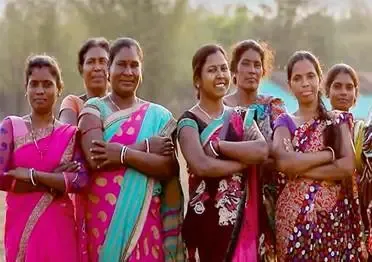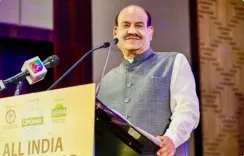How are Women Central to India's Growth Story?

Synopsis
As India celebrates 11 years of the Modi government, the focus on women's empowerment takes center stage. Discover how initiatives like Nari Shakti are reshaping the landscape for women across the nation, fostering dignity, safety, and leadership in various sectors.
Key Takeaways
- Nari Shakti is vital for women's empowerment in India.
- Legislative changes have enhanced women's rights.
- Women are leading in various sectors like entrepreneurship and governance.
- Key initiatives focus on health, education, and financial inclusion.
- Women's empowerment is essential for national growth.
New Delhi, June 8 (NationPress) As the BJP-led NDA administration commemorates its 11 years in office, it proudly announces "New Momentum for Nari Shakti - 11 Years of Shashkt Nari"—a decade-long commitment to enhancing women's roles through focused reforms and visionary initiatives.
The Central government, in an official statement, has celebrated its achievements as a transformation of Indian women from "passive recipients to active agents of change, integral to India’s growth narrative."
Nari Shakti, now regarded as a national mission, aspires to empower every woman—whether urban or rural, young or old—to live with dignity, safety, and independence.
The government asserts that this approach has been bold, inclusive, and lifecycle-oriented, covering healthcare, education, digital access, sanitation, financial inclusion, and beyond.
Prime Minister Narendra Modi has consistently emphasized that India's advancement is only achievable through the empowerment of its women.
Since 2014, women have progressively taken the forefront in entrepreneurship, science, defense, sports, and governance.
With women and children constituting nearly 67.7 percent of the population, the government perceives women’s empowerment not just as a social reform but also as a strategic necessity for national development.
The Modi administration's initiatives have been rooted in a comprehensive, lifecycle-based policy framework. Landmark programs such as Beti Bachao Beti Padhao, Mission Shakti, and the constitutional enactment of the Nari Shakti Vandan Adhiniyam have transitioned the focus from women's development to women-led development.
This legislation reserves 33 percent of seats in the Lok Sabha and State Assemblies for women, including representation for SC and ST women—a legislative milestone in India's democratic evolution.
Women's presence in education, particularly in STEM fields, skilling initiatives, and entrepreneurship has soared.
Legal and labor reforms have enhanced workplace safety, while schemes like PM Awas Yojana, DAY-NRLM, and support for women farmers have deepened financial and social empowerment.
Health and nutrition have been pivotal in the government's strategy. Mission POSHAN integrates nutrition and health services for children, adolescent girls, and mothers.
Under Mission Saksham Anganwadi and Poshan 2.0, the Centre aims to upgrade two lakh Anganwadi Centres by the conclusion of the 15th Finance Commission cycle.
The Poshan Bhi Padhai Bhi initiative merges early education with nutrition, and the award-winning Poshan Tracker app has modernized monitoring efforts.
Additional programs such as Janani Shishu Suraksha Karyakram, Janani Suraksha Yojana, SUMAN, PMSMA, and PM Matru Vandana Yojana have improved maternal and child healthcare.
The government also highlights housing and hygiene initiatives like PMAY-G, Swachh Bharat Mission, and Jal Jeevan Mission as transformative, particularly for rural women. Sukanya Samriddhi Yojana and Beti Bachao Beti Padhao continue to foster girls' education and financial independence.
In defense, STEM, and public administration, Indian women are now assuming leadership roles once deemed unattainable. With the enactment of the Nari Shakti Vandan Adhiniyam, their influence in governance will be permanently etched into India's democratic framework.
Significant legal reforms have also defined this decade. The abolition of Triple Talaq provided Muslim women with long-overdue dignity and protection. Increasing the legal marriage age from 18 to 21 has allowed young women to prioritize education and careers.
Maternity leave has been extended to 26 weeks, and with the repeal of Article 35A, women in Jammu and Kashmir now enjoy equal property rights.
Women entrepreneurs have received particular attention. Key programs like PM MUDRA Yojana, Stand-Up India, and DAY-NRLM have dismantled barriers to institutional credit and fostered grassroots innovation.
Mission Shakti, initiated in mission mode, continues to unify efforts across sectors and lifecycle stages to ensure safety and empowerment.
The government asserts these policies have transformed social welfare from a mere safety net into a springboard for dignity, leadership, and opportunities.
"From housing to hygiene, each initiative has uplifted lives and fortified the foundation of Nari Shakti in rural India," the Centre stated.
According to the government, the last eleven years have not only seen an increase in women's participation across sectors but have also institutionalized a framework to sustain and enhance this progress.
With India poised to enter Amrit Kaal, the Centre envisions Nari Shakti as the driving force behind a stronger, more inclusive nation—where women are not merely participants but leaders, innovators, and architects of the future.





